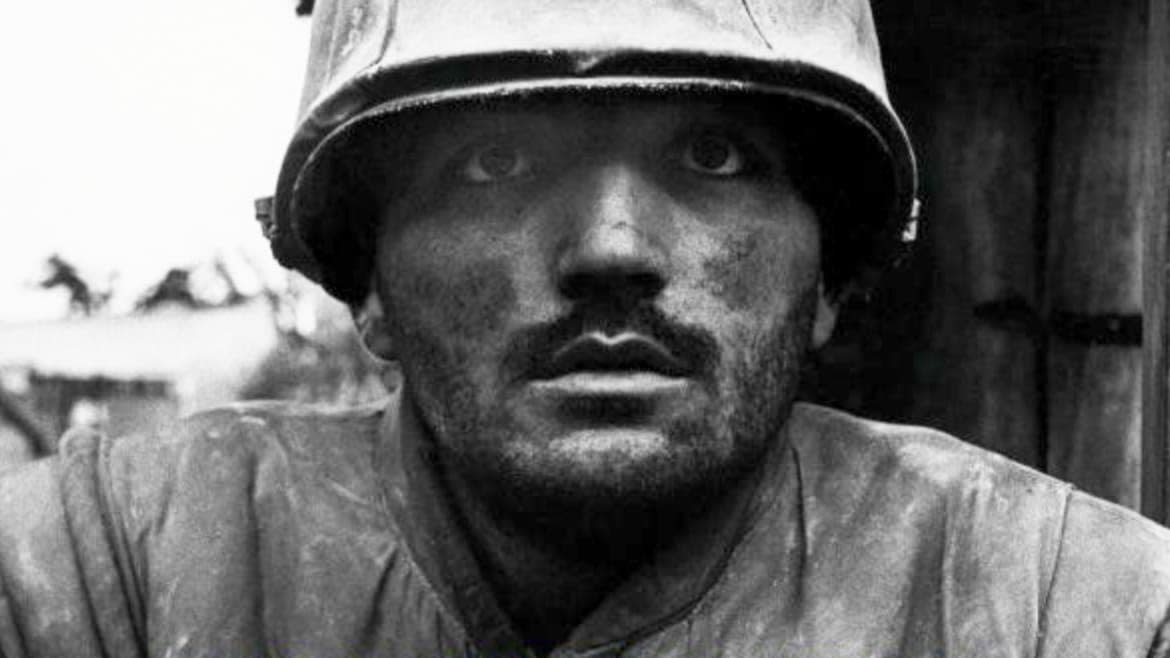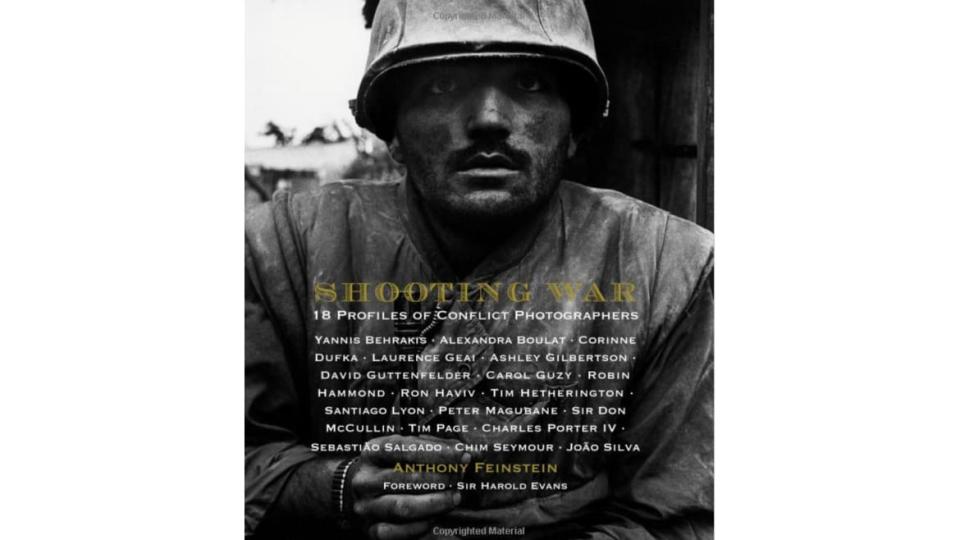Photographers Who Bear Witness to War Pay a Steep Price

In 1992, photographer Ron Haviv was on assignment in Bosnia, documenting the civil war in former Yugoslavia. He was in the town of Bijeljina when he ran into Zeljko Raznatovic, leader of a paramilitary force known as Arkan’s Tigers, whom Haviv had previously photographed.
Haviv followed Arkan’s Tigers as they, in Raznatovic’s words, “cleansed the town of Muslim fundamentalists.” Haviv watched as the paramilitaries executed a middle-aged man and two women on a street corner. The gunmen shouted at Haviv not to take any photographs, but he managed to shoot a couple of frames while hiding behind a crashed truck. Five years later, Raznatovic was indicted by the international war crimes tribunal in the Hague, with Haviv’s photographs being used as supporting evidence.
Haviv’s story is just one of many that Anthony Feinstein tells in his recent book, Shooting War. A collection of some of history’s most powerful conflict photos, along with profiles of the people behind the cameras, Feinstein’s book examines the human cost of bearing witness to wars, natural disasters, and other staggering crises.
How to Be a War Photographer and Working Mom
Not a photographer himself, Feinstein is a neuropsychiatrist. He first became interested in war journalism in 1999, when counseling a reporter who had developed significant psychological issues in the course of her work. Looking for previous studies on the intersection of journalism and mental health, he found nothing, inspiring him to conduct the research himself. Two decades and many studies later, he is now perhaps the pre-eminent expert on the effects of conflict on the journalists who document it.
Both Feinstein’s research and the stories in Shooting War give evidence of the intense psychological and emotional toll placed upon conflict photographers. He estimates that rates of post-traumatic stress disorder, for example, are comparable between journalists who have been covering conflict for 30 years and veterans who have seen combat. Shooting War puts a human face to such statistics: Feinstein relates how Ron Haviv, for example, feared retribution from Raznatovic for his photo of Arkan’s Tigers until 2000, when the paramilitary leader was assassinated in Belgrade.
Although the book’s profiles occasionally leave you wanting to know more about such significant moments captured on film, Feinstein typically shares enough context for the reader to appreciate both the photograph and the photographer.
I recently spoke with Anthony Feinstein about journalism, crises, and what happens when photographers are caught between the two. Our conversation has been lightly edited for clarity and brevity.
As a neuropsychiatrist, what first drew you to conflict photography?
I first became interested in war journalism in 1999, when I was referred a patient who was a war journalist and who had developed a very significant stress response syndrome that made it impossible for her to continue working. My patient did very well with psychotherapy, and after she had recovered, I learned, to my surprise, that her large news organization had not made any counseling available to her—notwithstanding the fact that she had spent more than a decade covering some of the world’s most dangerous places. I am not just a clinician, but also a behavioral science researcher, and in response to my patient’s revelation, I did a detailed literature search to see what had been written on the subject of war journalism and emotional health. To my surprise I found not a single article devoted to the topic, even though there is a very large amount of trauma literature focusing on veterans, fire fighters, victims of assault and rape, and so on.
Faced with this dearth of information, I wrote a grant application and sent it to the Freedom Forum in Washington, D.C., and they funded the very first study of war journalism and post-traumatic stress disorder. The study was published in 2002 in the American Journal of Psychiatry.
Since then, I have gone on to do studies looking at journalists covering the war in Iraq, a UNESCO-funded study looking at Mexican journalists and the challenges and dangers of covering the drug wars in their country, the response of Kenyan journalists to the terrorist attacks of Al Shabab, the effects of state-sponsored violence on journalists in Iran, the psychological effects of prolonged civil war on journalists covering the Syrian conflict, and more recently, the emotional effects on journalists who have been following the migrations of large numbers of people in the Middle East and Africa through Europe.
You mentioned that your client's news organization did not provide her with any counseling. Has that changed since 1999?
There has indeed been a sea change in attitude among many—but not all—new organizations. Counseling is now routinely offered, when necessary. Over the past few years, The New York Times, for example, has had me provide education sessions on psychological trauma to all their foreign correspondents, and I am now doing this for many of their domestic reporters too.
However, there are still many news organizations who are not sensitive to these issues, and what is really striking is that, when I have undertaken studies in countries like Mexico and Kenya, news organizations there turn a blind eye to psychological distress in their journalists. It is not even acknowledged even when it is in plain sight.
What impact does covering conflict have on journalists?
The majority of journalists who cover conflict do not develop post-traumatic stress disorder or depression or substance abuse. However, the minority that do is substantial. It is well above the numbers seen in journalists who confine themselves to local reporting in countries such as Canada and the United States. The rates of PTSD and depression are significantly elevated compared to the general population.
If one looks at a cumulative percentage, i.e., what are the rates of PTSD and depression in journalists over the course of a 30-year career covering war and conflict, then one arrives at a figure that is very close to that seen in combat veterans. The main disorders are post-traumatic stress disorder, major depression, generalized anxiety disorder, and substance abuse.
Many of the photographers profiled in Shooting War decline to identify themselves as “war journalists,” instead pointing out that they cover refugee crises or the fallout of natural disasters. Does that distinction tell us something about the nature of “conflict?” Should we understand that word differently?
You are correct in noting that the journalists in my book cover more than war. My database, which now runs to over 900 frontline journalists and which has been amassed over the past 20 years, reveals that natural disasters, man-made disasters, and revolutions can also be very difficult events for journalists to cover.
The earthquake in Haiti is a good example in question, given that many of the journalists who spent time in the devastated country reported some significant symptoms of emotional distress.
That said, one of the distinguishing features of war is that journalists are at greater personal risk relative to a natural or man-made disaster, and the greater danger that comes with work like this is, in theory, considered a more significant stressor. That said, witnessing mass death as in a tsunami disaster, for example, can prove very difficult emotionally for journalists as well. The psychiatric disorders that arise in response to covering disasters and revolution do not differ in content from that seen after war. It is more a matter of frequency, with symptoms being somewhat less prevalent in non-war situations.
Politics is a subject not openly broached in Shooting Wars but is present in every photograph and profile therein. From your perspective, how do personal politics influence conflict photographers?
Journalists frequently tell me that they try not to take sides in conflicts and would prefer to keep their objectivity. However, there are numerous conflicts in which it is apparent that one party is the aggressor and the other is not.
In my experience, journalists tend to side with the underdog or those who they feel are on the right side of history from a moral perspective. An excellent example of this was the prolonged civil wars that led to the dismemberment of Yugoslavia. Here journalists who spent many years covering the conflict were generally much more sympathetic to the Bosnians than the Serbs or Croats, and many journalists became emotionally invested in the conflict. While this was understandable, from a psychological perspective it left them at greater risk when it came to developing symptoms of emotional distress.
There is also evidence that some of the remarkable photographs taken by these conflict photographers can shape political events. The classic example from my book is Ron Haviv’s photograph of the rogue Serb paramilitary committing acts that came to be viewed as war crimes. The picture of the Serb militiaman, cigarette in hand, kicking a dead, elderly Bosnian civilian recently executed became a rallying cry for Bosnians in general and was used as evidence at the war crimes tribunal in the Hague.
There is an inherent tension revealed through many of your profiles—that of the photographer tasked with capturing the scene and the human being behind the camera, who is either compelled to aid in the unfolding situation or to flee for safety. What are the consequences of conflict photographers being torn in these two opposing directions?
The issue that you touch upon here is that of “moral injury.” This is not a mental illness, and journalists and news organizations have been slow to recognize it as a potential problem. The military are familiar with it going back to the 2003 war in Iraq and even before that. In short, what moral injury refers to is a person feeling that he or she has betrayed their moral compass and let themselves down morally by doing something that they regret or, alternatively, by failing to act in a particular situation.
Interestingly, in my recent work with journalists covering the migration crisis, I found low levels of PTSD, depression, and substance abuse, but significant evidence of moral injury, which is a condition associated primarily with shame and guilt.
Journalists have to make difficult decisions, often in times of extremis. Do you help the person or do you not? Should you help, how far do you go? Faced by multiple people in difficulty, who do you help?
The challenges extend beyond the immediacy of the moment. Journalists ask themselves how their news organizations have responded to particular crises. Did their news managers make the right call? There are no easy answers to these questions, but journalists can look back on their actions in emotionally fraught situations and not infrequently feel that their behavior failed to meet their moral code. As mentioned, moral injury is not a mental illness, but the military have shown that, should this particular set of emotions be left unattended, it may become a conduit to depression and even post-traumatic stress disorder.
How do you see journalists productively dealing with moral injury?
I believe that journalists—not psychiatrists—must work this out. My view is that the industry needs to have a discussion on this topic and come up with a set of guidelines to address the challenge. Some involvement/intervention on the part of journalists seems inevitable to me, but the question is, where does this stop? It also seems imperative to have a unified organizational approach to the question, so that everyone is on the same page, as it were, and journalists in the field who are exposed to the rawest emotions are not left bumping heads with managers sitting a world away in some comfortable office.

Get our top stories in your inbox every day. Sign up now!
Daily Beast Membership: Beast Inside goes deeper on the stories that matter to you. Learn more.

